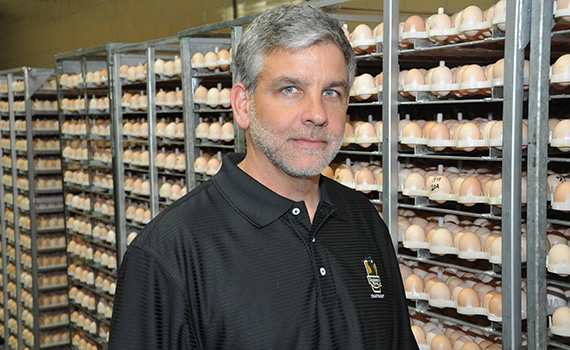



Infectious bronchitis DMV 1639: More questions than answers
Infectious bronchitis virus (IBV) has affected flocks before the virus was even identified. In the US, IBV strains are named for the state from which they were first isolated. There are strains named after Massachusetts, Connecticut and Arkansas, and several Georgia subtypes have been discovered.
The most recent IBV variant apparently started in Pennsylvania but was isolated and named on the Delmarva Peninsula, so it’s called DMV 1639. In broilers, DMV 1639 IBV started out as a nephropathogenic virus affecting portions of a flock inside one chicken house on a farm. The clinical presentation was reported to be classic sick chickens that huddled, were lethargic and didn’t eat or drink normally. Unique to DMV 1639 was the amount of wet litter from affected birds flushing non-concentrated urine. However, as time went on more flocks emerged with the classic respiratory presentation and fewer with the “kidney” presentation.
As DMV 1639 moved from the mid-Atlantic area down the eastern seaboard then west to Mississippi and Texas, the clinical presentation in broilers changed to almost exclusively respiratory signs.
Other changing IBVs
Another IBV — GA08 — can change clinical presentation as well, but this is due mainly to the timing of infection. Initially, broiler flocks were often described as having “silent airsacculitis.” Many commercial broiler producers in the Southeast US reported no clinical signs in affected flocks until the carcasses were inspected at processing. Over half of the flock had some type of airsacculitis requiring extra trimming after evisceration.
Our first cases of GA08 were similar to those reported by others, but at some of our locations, the pattern changed during the second year. The virus manifested more often as field mortality, frequently due to secondary infections with Escherichia coli septicemia and less as post-harvest processing problems.
When there’s lower field-infection pressure from GA08 — less virus — and flocks are affected later in life, they don’t have time to die from E. coli. However, when GA08 gets established, builds up and flocks get challenged at an earlier age — say 2 to 4 weeks of age — there’s time for E. coli to take its toll.
So, DMV 1639 and GA08 have both changed with time, though in different ways.
DMV 1639 in broiler breeders
Within the past 12 months, we’ve isolated DMV 1639 from broiler breeder flocks in mid-lay. In some of the first affected flocks, feed consumption was delayed beyond normal clean-up. As more flocks were diagnosed with DMV 1639, there were more reports of a transient, low-prevalence respiratory sound that could be heard for 1 to 3 days, with affected birds shaking their heads and breathing open-mouthed.
After 3 to 5 days, respiratory signs were no longer evident. The impact on egg production ranged from no impact at all to as much as a 20% egg production loss — either occurring with feed refusal or about 1 week following feed refusal. Most affected flocks had some amount of vent-feather uric acid staining, particularly in hens, but this was also seen on some roosters.
Cross-protection
Two commercial GA08 IBV vaccines reportedly provide some cross-protection for DMV 1639, typically when used in combination with other IBV vaccines, primarily Massachusetts IBV. As of this writing, we’ve found that using a full dose of Mass IBV plus the GA08 vaccine on day of age protects broilers and breeders, and in breeders, that protection has persisted into lay.
We have also found that GA08 vaccines do not interact well with some other commercial vaccines, particularly Arkansas IBV vaccines, and that it can sometimes result in airsacculitis and mortality. In fact, at least one US research report indicates that combining Arkansas and GA08 vaccines might actually interfere with protection against a homologous GA08 challenge.1,2 However, there are differences in Arkansas IBV vaccines,3 so maybe the experience differs depending on the Arkansas IBV vaccine used.
Lingering questions
Cross-protection against wild DMV 1639 challenges from other IBV serotypes may prove effective enough to limit mortality and morbidity, but the commercial poultry industry is still learning about the ramifications of DMV 1639 in broiler and breeder populations. There are a multitude of lingering questions.
Will all GA08-vaccinated broilers be protected from DMV 1639 field challenges? Will it vary region to region? Does DMV 1639 in Texas still present the same as it did when it first emerged in Pennsylvania — a question we need molecular and pathotype analyses to answer? What’s the impact of moving vaccinated birds into naïve populations — for instance, moving younger GA08-vaccinated spike male roosters into older, unvaccinated breeder hen flocks?
Just using GA08 vaccines — with or without other IBV serotypes — is no guarantee for success against DMV 1639 or even GA08. We do know that what’s sometimes considered vaccine failure may actually be due to improper vaccine preparation and administration, and that correct handling of vaccines is just as important as serotype selection. Both customers and suppliers are obligated to ensure administration is done correctly.
For now, there are more questions than answers about DMV 1639. However, as with other diseases, I predict we poultry veterinarians will learn more about DMV 1639 long before our physician counterparts figure out COVID-19.
| References | ||||
|---|---|---|---|---|
| 1 Stayer PA, et al. Various Manifestations of GA08. Am Vet Med Assoc annual conference, Indianapolis, Indiana. 2017 July 23. | ||||
| 2 Stayer PA, et al. When GA08 Ain’t 08. Mississippi Poult Assoc Poult Dis Seminar, Jackson, Mississippi. 2017 Feb 22. | ||||
| 3 Van Santen V, et al. Rapid selection in chickens of subpopulations within ArkDPI-derived infectious bronchitis virus vaccines. J Avian Pathol. 2008;37(3). | ||||











